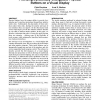Free Online Productivity Tools
i2Speak
i2Symbol
i2OCR
iTex2Img
iWeb2Print
iWeb2Shot
i2Type
iPdf2Split
iPdf2Merge
i2Bopomofo
i2Arabic
i2Style
i2Image
i2PDF
iLatex2Rtf
Sci2ools
CHI
2009
ACM
2009
ACM
Providing dynamically changeable physical buttons on a visual display
Physical buttons have the unique ability to provide lowattention and vision-free interactions through their intuitive tactile clues. Unfortunately, the physicality of these interfaces makes them static, limiting the number and types of user interfaces they can support. On the other hand, touch screen technologies provide the ultimate interface flexibility, but offer no inherent tactile qualities. In this paper, we describe a technique that seeks to occupy the space between these two extremes ? offering some of the flexibility of touch screens, while retaining the beneficial tactile properties of physical interfaces. The outcome of our investigations is a visual display that contains deformable areas, able to produce physical buttons and other interface elements. These tactile features can be dynamically brought into and out of the interface, and otherwise manipulated under program control. The surfaces we describe provide the full dynamics of a visual display (through rear projection)...
Beneficial Tactile Properties | CHI 2009 | Human Computer Interaction | Inherent Tactile Qualities | Intuitive Tactile Clues |
| Added | 24 Nov 2009 |
| Updated | 24 Nov 2009 |
| Type | Conference |
| Year | 2009 |
| Where | CHI |
| Authors | Chris Harrison, Scott E. Hudson |
Comments (0)

